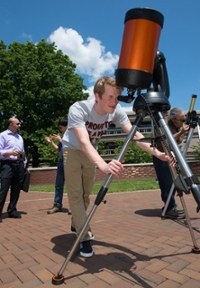Members of the Southern Illinois University Edwardsville community gathered around two telescopes and donned special filtered glasses on Thursday, May 19 to view sunspot #2546. The sunspot is nearly three times the size of Earth, and will remain visible for approximately five to seven days.

“Sunspots occur on a semi-regular basis, but this one is enormous,” said James Votsmier, lab specialist and lecturer in the Department of Physics in SIUE’s College of Arts and Sciences. “It’s not perfectly round. It has more of an amoeba shape to it.”
“Sunspots are, in a sense, magnetic dams caused by turbulence in the convection region,” added Jeffrey Sabby, PhD and associate professor of physics. “Moving charges in the very turbulent convective layer of the sun, the layer just below the photosphere, or what we see, create localized magnetic flux tubes that are buoyant. Some of these buoyant localized flux tubes rise through the convective layer of the sun and pierce the photosphere. We see them as sunspots.”
Sunspots appear dark due to the fact that they are restricting the normal flow of energy.
“If we were to view these magnetic loops as is we were standing on the “surface” of the sun, we would see that these rising flux tubes piercing the photosphere form prominences, giant arching structures where you can see the flow of plasma along the magnetic field lines,” Sabby added.

“There’s a magnetic “storm” on the surface of the sun that results in a slightly cooler region compared to the rest of the surface,” added Jack Glassman, PhD and associate professor physics. “The sunspot is in the range of 6,000-7,000 degrees Fahrenheit, and the rest of the surface is approximately 10,000 degrees.”
Votsmier emphasized to the nearly 300 spectators that it is not safe to look at the sun with the unprotected eye. He encourages people to view the magnificent sunspot safely by using Eclipse Safe glasses, #14 welding glass or something equivalent, with an optical density of five or greater.
“Those devices offer a filtering material that cut down the intensity of the light to where its manageable,” he explained. “It also cuts out the ultraviolet and infrared. Under no circumstances should a person look at the sun with the unprotected eye, because it will cause irreversible damage.”
According to Votsmier, the sunspot will continue to wander across the surface of the sun and may reappear later in the sun’s 25-day rotation cycle.
For a current set of Solar Dynamics Observatory images highlighting the sunspot observed Thursday, May 19, visit http://sdo.gsfc.nasa.gov/data/.
Central to SIUE’s exceptional and comprehensive education, the College of Arts and Sciences has 19 departments and 85 areas of study. More than 300 full-time faculty/instructors deliver classes to more than 8,000 undergraduate and graduate students. Faculty help students explore diverse ideas and experiences, while learning to think and live as fulfilled, productive members of the global community. Study abroad, service-learning, internships, and other experiential learning opportunities better prepare SIUE students not only to succeed in our region's workplaces, but also to become valuable leaders who make important contributions to our communities.
Photos:
This sunspot was photographed on May 19.
SIUE Engineering Student worker Mark Hancock takes a look at the sunspot.